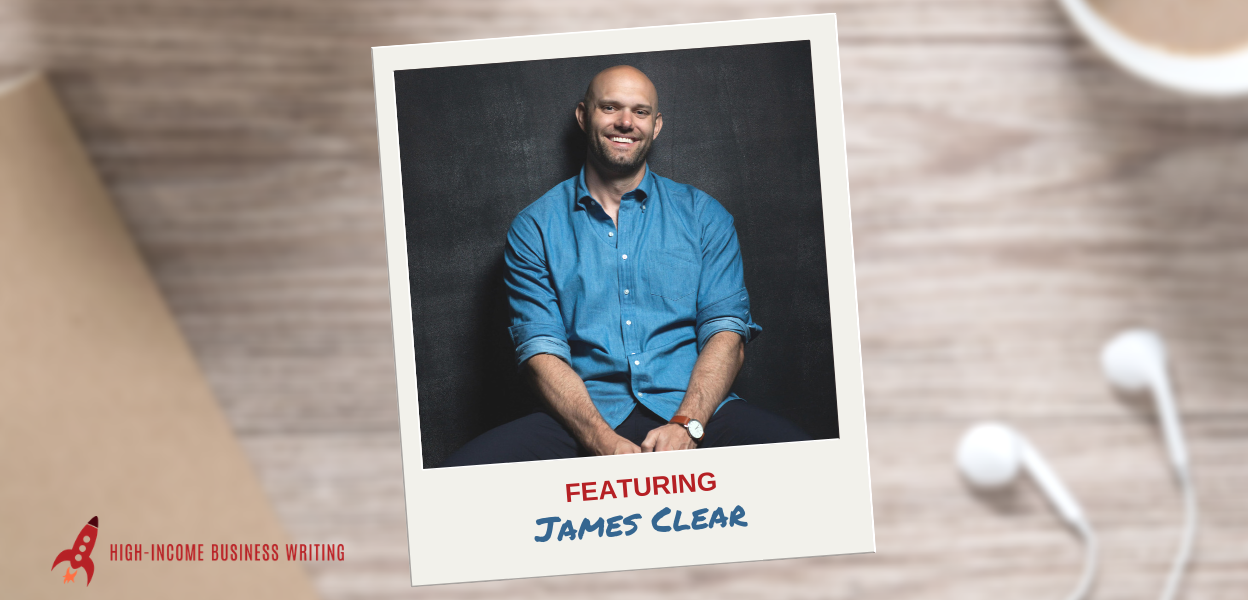“You don’t rise to the level of your goals. You fall to the level of your systems.”
–James Clear
As a freelance professional, your habits and systems will directly determine your level of success and happiness.
That’s true for everyone. But even more so for self-employed professionals.
When you’re the boss, it’s all up to you. There’s no one looking over your shoulder. No one in the office trying to sabotage your efforts. No one checking to see when you clocked in or out.
So if we want to succeed, it’s more important than ever to develop and maintain the right habits.
Until recently, practical advice in this area was mostly anecdotal and untested. But over the past decade, new research and discoveries in the field of behavioral science has changed this.
And one of the experts in this field is my guest for this week’s episode, James Clear.
James is the author of the newly released book, Atomic Habits: An Easy & Proven Way to Build Good Habits & Break Bad Ones. He’s an author and speaker focused on habits, decision-making, and continuous improvement. His work has appeared in the New York Times, Entrepreneur, Time, and on CBS This Morning.
James’ website receives millions of visitors each month, and hundreds of thousands subscribe to his popular email newsletter at jamesclear.com. He is a regular speaker at Fortune 500 companies and his work is used by teams in the NFL, NBA, and MLB.
This is a fascinating interview with a guy who thinks about this topic day and night. He’s spent years applying the science to everyday situations you and I face regularly in our businesses.
The notes that follow are a very basic, unedited summary of the show. There’s a lot more detail in the audio version. You can listen to the show using the audio player below. Or you can subscribe in iTunes to get this show delivered straight to the Podcasts app on your smart phone, tablet or iPod.


High-Income Business Writing with Ed Gandia
#163: James Clear on an Easier Way to Build Good Habits as a Freelancer
How did you become passionate about habits?
James was an athlete in college. As part of his training, he developed many useful habits that he continued after he left school. While they worked for him, he couldn’t explain why.
Later, James started a number of businesses. Some of them failed, and he wanted to understand why. This got him interested in behavioral and consumer psychology.
He started to write about habits and related topics. In November 2012, he published an article that took off.
Within two years, he had over 100,000 subscribers. Today, a couple million people visit his site every month.
Why do you think this topic resonates with people?
1. We all have habits.
Good and bad habits shape our lives. Research says that 40-50% of our behaviors every day are habitual.
2. You can encourage good habits and discourage bad habits.
We don’t just have to accept our current habits. We can take steps to develop new ones and drop old ones. Changes don’t have to be large to make a difference in our lives.
Setting a goal doesn’t do much to help you reach that goal. What will influence whether you reach that goal is the system you have in place.
We don’t rise to the level of our goals; we fall to the level of our systems.
Habits are automatic solutions to the problems we face every day. But habits that you unwittingly adopted to solve those problem aren’t necessarily the best solution.
Once you realize this, you can see which habits you need to adjust.
Become the architect of your habits, not the victim.
How can we build good habits?
Every habit consists of four stages. Each stage has a lever you can pull to build good habits.
Stages of a habit:
1. The cue. Prompts you to do the habit.
2. The craving. A prediction or interpretation of the cue.
3. The response. The habit behavior.
4. The reward. Satisfies the craving and teaches you for next time.
Each of these stages has a lever you can use to build a better habit:
- Cue lever: Make it obvious
- Craving lever: Make it attractive
- Response lever: Make it easy
- Reward lever: Make it satisfying.
How would this apply to someone who’s struggling to prospect consistently, for example?
For new client prospecting, let’s look at two levers: 1) make it obvious and 2) make it easy.
1. Make it obvious
Start with environment design. You want to build an environment where less willpower is required to complete the task—where you don’t have to overpower the environment to get the task done.
People with high self-control don’t have superior willpower. They’ve just structured their environment so that they face fewer temptations.
So in this case, you want to reduce your exposure to things that can pull you away from prospecting work, such as turning off phone notifications, unplugging the TV and/or setting up a separate work space.
The more you “make things obvious” in your environment, the more likely that you’ll develop positive habits that are associated with that space.
2. Make It Easy
The “friction” associated with completing a task has a big influence over whether it gets done or not.
Look for bottlenecks where you can resolve tension. Map out your process and look for ways to reduce friction. Eliminate, automate, and streamline.
Often, sending out emails is a friction point in prospecting. Reduce the friction by doing it first thing in the morning. Or identify to whom you’ll send the emails the day before.
What role does accountability play in all this?
When you belong to a group or tribe, you want to adhere to the expectations and norms of that group.
If you can find a group where your desired behavior is the norm, the group becomes a powerful form of behavior change and habit formation.
To feel like you belong in the group, you have to keep up the behavior—which is a positive form of peer pressure.
An example: For many people, going to the gym four days a week feels like a big sacrifice. But for other people, it’s completely normal behavior. If you become part of that group, getting to the gym will become the norm.
This is called implicit accountability.
Tell us about your new book
James’ new book is Atomic Habits: An Easy and Proven Way to Build Good Habits and Break Bad Ones.
It teaches you how to make small changes that will transform your habits and deliver results.
James’ website: https://jamesclear.com
By the way … whenever you’re ready, here are 4 ways I can help you grow your freelance business:
1. Grab a free copy of my training class for writers who are new to freelancing.
It’s called “The 3 Magic Levers: How to Get Your Writing Business Off the Ground and Land Your First Paying Client.” — Click Here
2. Download a free copy of my book for ESTABLISHED writers/copywriters.
You’ll discover how to quickly and predictably reawaken dead leads, generate new client opportunities and convert not-yet-ready prospects into freelance writing clients. — Click Here
3. Join our “Get Better Clients Academy”
You’ll get a personalized action plan based on where you are today in your business. Plus all the tools, scripts, checklists, cheat sheets and templates you’ll need to escape feast-or-famine … grow your income … and land clients who love and respect you. — Click Here
4. Get your website DONE!
If you’ve been struggling to get your website done … or if you’re not happy with what you’ve got today… let my team and me build you a beautiful website for your writing business. We’ll do all the hard work! Email me at ed@b2blauncher.com … put “WEBSITE” in the subject line … and I’ll reply with the details.






